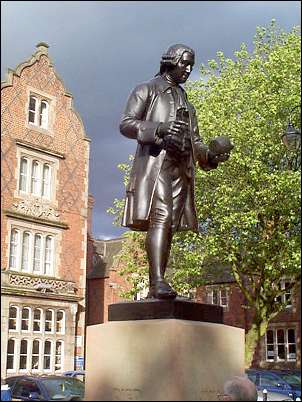|
Description:
Josiah Wedgwood I is depicted
wearing contemporary dress of frock coat, buckled shoes,
breeches and wig.
He holds a copy of the Portland Vase, a Roman artefact in
glass, of which his Burslem Manufactory made 50
reproductions in 1790.
About the subject:
Josiah Wedgwood I (1730-1795)
was born in Burslem, now one of the six towns of 'the
Potteries' or Stoke-on-Trent, Staffordshire.
After completing an apprenticeship he opened a successful
manufactory in Burslem in 1759, and in 1769 another one near
Hanley, which he called 'Etruria' in the incorrect belief
that Greek vases were Etrusacan in origin. Etruria included
a model factory, workers village and mansion.
A relief in Stoke Church by
John Flaxman (1755-1826) records that he, 'converted a rude
and inconsiderable Manufactory into an elegant Art and An
important part of the National Commerce'.
Background:
The original idea for erecting
the statue of Wedgwood was Joseph Mayer's. On 24 January
1859 a Statue Committee was formed following a meeting
chaired by the Mayor of Hanley, John Ridgway.
The reason for siting the work
in front of the railway station rather than anywhere more
central was that it would therefore be on the boundary of
Hanley and Stoke-on-Trent, both of whom laid claim to being
the home of Wedgwood.
It was the Statue Committee's
decision rather than the artist's that Wedgwood should be
depicted together with his famous achievement, the Portland
vase. The artist initially submitted a model with the vase
standing on a pedestal next to Wedgwood, but this was
changed in favour of the current design showing him in the
pose he had adopted when lecturing about his production
after it was decided that the figure should be in bronze
rather than stone.
The inauguration of the statue
was delayed for about a year while it was shown at the
International Exhibition of 1862. A contemporary critic from
the London Illustrated News described it as 'a thoroughly
sound and manly work of art, the likeness being founded on a
portrait by Sir Joshua Reynolds'. He spoke of the great
novelty of the design lying in the absence of any
conventional pedestal depicting 'pitchers, pillar, pile of
books, stump of tree, heap of machines, hanging drapery of
cloak or what not - an innovation which cannot be too highly
commended'.
The unveiling ceremony for the
statue included processions from each of Stoke-on-Trent's
six towns, and an extravagant meal for the gathered
dignitaries at the North Stafford Hotel.
The statue was unveiled by the
Earl of Harrowby.
In 1957 a bronze cast was
erected outside Wedgwood's Barlaston factory. This was made
from the original plaster cast model discovered in a storage
depot and repaired by Wedgwood's then chief modeller, Eric
Owen.
 |
![]()
![]()
![]() Index
of all Stoke-on-Trent art |
Index
of all Stoke-on-Trent art |
![]() Index
of all Stoke-on-Trent art |
Index
of all Stoke-on-Trent art |